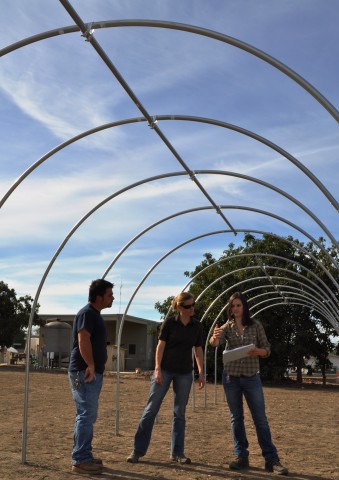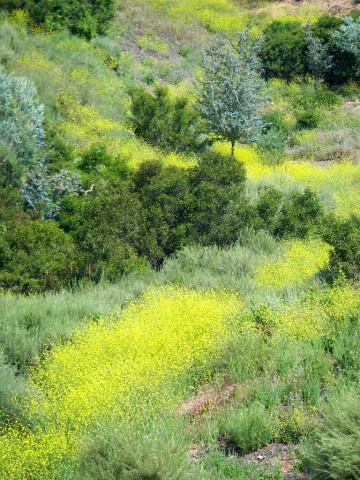
Assistant Professor Jennifer Funk, center, works with Chapman research technician Julie Larson and UC senior farm maintenance engineer Chris Martinez at the greenhouse site.
Botanist Jennifer Funk, Ph.D., is all about plants. She’s studied the challenges of invasive species from Australia to California. She teaches plant biology as an assistant professor in the School of Earth and Environmental Sciences. In Hawaii she investigated which native plants were most likely to outperform invasive species.
But at her research site near the Orange County foothills one recent morning, the Chapman University scientist was delighted to see steel supports planted in concrete bases, the framing of what will become a series of greenhouses where she will conduct long-term research on native and non-native plants and their responses to drought and climate change.
“We’re here to stay,” Funk said, as she checked in on the project site located at the University of California’s Agriculture and Natural Resource Research and Extension facility in Irvine.
That particular kind of rootedness is thanks to a five-year, $612,000 National Science Foundation grant Funk was awarded for her project looking at plant adaptability. The NSF grant is a Faculty Early Career Development award, a prestigious NSF program that supports junior faculty who exemplify the role of teacher-scholars through outstanding research and teaching.
Understanding plants’ response to drought over an extended time has numerous implications, from planning habitat preserves for animal life to managing wildfire hazards, Funk says. It’s particularly critical because the plants Funk chose for her project, including the ubiquitous black mustard that blankets the state’s hillsides, are here to stay.
“Some of these are so entrenched that we’re never going to get rid of them, in particular the grasses,” she says.

The colorful but non-native black mustard is among the species to be studied in long-term project.
Funk’s goal is to better understand how the vegetation that grows throughout the region’s hillsides and canyons will fare in the dryer conditions forecast by climate scientists. Native shrubs tend to be deep-rooted and seemingly better equipped to survive drought, while non-native grasses are shallow-rooted and would presumably suffer more, she says. But no one knows for sure. Those deep roots shore up reserves that can make all appear fine above ground when, in fact, the plants are struggling, Funk says.
“They just might act like nothing’s happening because they have so much underground to keep them going,” she says. “It takes them about five years to respond to drought.”
Happily, she now has the time to measure that kind of change. So over the next few years Funk, along with a research technician and student researchers, will use the greenhouses to grow and observe 10 plant species under controlled “rainfall” conditions. Some plants will receive average rainfall, others 150 percent that amount, and a third batch just 50 percent of normal precipitation.
The continuing project is ideal for undergraduate students to experience meaningful and hands-on research, she says.
“In the sciences, students do a lot of data analysis, but they’re often from canned data sets. But this is a real data-collecting experience that they can come out and be part of,” she says.
Ideally, Funk would like to keep that work going for many more years. Her hope is to obtain additional funding, creating a study that could measure plant adaptation over decades.
Looking around the open field where her greenhouses will soon harbor rows of shrubs and grasses, she smiled and said: “I want to work here for 30 years.”




Add comment